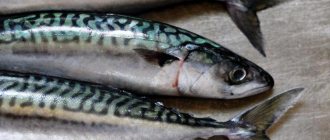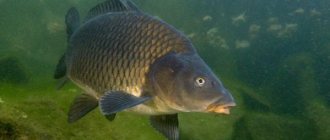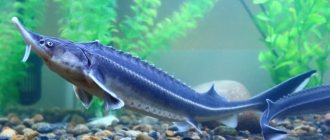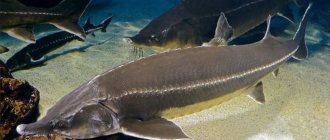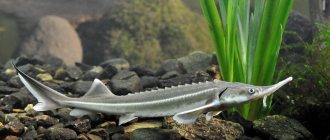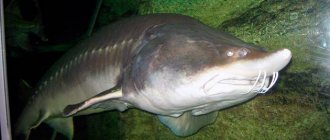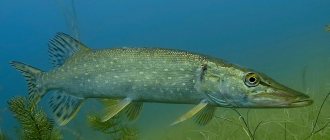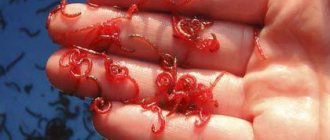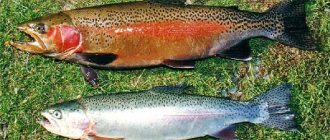Varieties of trout fish
There are three types of trout:
- Ruchevaya;
- Ozernaya;
- Rainbow.
Brook trout can grow more than half a meter in length and reach 12 kilograms at the age of 10 years. This is a large representative of the family. The body is elongated, covered with very small but dense scales. Has small fins. Her large mouth is covered with numerous teeth.
Lake trout has a stronger body than the previous subspecies. The head is compressed, the lateral line is clearly visible. It is distinguished by its color: its back is red-brown, and its sides and belly are silver. Sometimes you can see black spots on it.
Rainbow trout is a fish
, which according to scientists belongs to freshwater. The body is quite long and grows in weight up to 6 kilograms. Its scales are very small. It differs from its fellows in that it has a distinct pink stripe on its belly.
Trout species
As mentioned above, trout is a generic name that includes several varieties.
Trout are divided into two large species, which differ in many ways. The division occurs on a territorial basis. There are sea trout and freshwater trout.
Marine representatives also have several species: Adriatic, flathead, silver char, Clark salmon. All these species live in the seas. Some species of trout are similar to each other and have one common name: sea trout.
Freshwater trout can be found in numerous reservoirs of Eurasia and North America. It is divided into three main types:
- lake trout - a fish of this species has an elongated, strong body, with small fins and a powerful wide tail. The coloration of this species is not distinguished by the brightness of colors and variety of patterns. Dark spots and specks appear on a lighter background. They cover the entire skin and even the tail. The intensity of color largely depends on the body of water. If the bottom is dark and covered with pebbles, then the lake trout will be painted in dark colors. In transparent reservoirs with a sandy bottom the color is lighter. The belly is red or yellow. Lake trout are semi-predatory, so their teeth are not as pronounced as other species.
- Rainbow trout - the name is fully justified by the color of this species. The color of the fish can be golden or silver, with bright spots. When you take a rainbow trout out of the water, it comes in all sorts of colors. During the spawning period, a bright scarlet line appears along the entire side of the fish. Rainbow trout can live in warmer waters than brook trout. Therefore, it is popular among lovers of artificial reservoirs for fishing.
- brook trout - this species is somewhat different from the previous two. Lake and rainbow trout have a laterally compressed body, while brook trout appear flattened on top.
The body is not brightly colored. The upperparts are greyish, with darker or reddish spots extending to the tail. The belly is white. Brook trout lives only in cold, clean water in the northern regions.
In addition to the three main ones, there are several more varieties of freshwater trout: marbled, golden, Sevan. All types of river trout are of both commercial and sporting interest.
Differences between male and female trout
Female trout differ from males in their larger body size, smaller head size and fewer teeth . Consequently, males, on the contrary, are smaller in body, with a large head and an abundant number of teeth. In mature males, the end of the lower jaws is often bent upward, which makes them just as easy to distinguish from females. The meat of both can be colored in different colors - white, yellowish or reddish.
How to distinguish a female from a male
Determining the gender of a caught carcass is quite easy; anyone who knows the simple rules can do it:
- The female, as a rule, has a larger body, but the head, on the contrary, is small, the number of teeth is also less than that of representatives of the stronger fish sex. — The male has a smaller body and a larger head. In the mouth there are many sharp teeth arranged in several rows. A mature male usually has a pronounced lower jaw, curved upward at the end. This distinctive feature makes it easy to determine gender.
Well, which of the individuals has caviar and which has milk, we won’t explain. Let's just say that the color of fish meat, regardless of gender, can be white, yellowish, or reddish.
Trout Habits
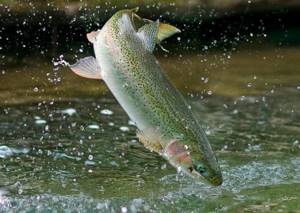
Trout is a cautious and fast fish that requires increased patience from the fisherman. Distinguished by her excellent eyesight, she perfectly sees everything that is happening on the shore, so it is very easy to scare her. It is extremely demanding and pretentious in relation to water, which leaves an imprint on the behavior of the fish: the habits of trout change depending on the reservoirs and conditions in which it has to live.
However, there is also a pattern in its behavior - trout comes out to feed (hunt) at dawn and dusk, and prefers to hide during daylight hours. For places of shelter where it stops, it chooses areas near depressions and rifts. There, the trout positions itself with its muzzle against the flow of water, counting on prey accidentally brought by the water. In this position, it is easiest for the fish not to be spooked and not to miss it.
Distinctive feature
Rainbow trout can have different colors, varying depending on external conditions, the quality and composition of water, soil, etc. however, the fish has an external feature peculiar to this particular species. We are talking about a clearly visible crimson stripe stretching along the line of the body on both sides. It is this stripe that distinguishes trout from many other fish of the salmon family. By the way, by the state of this strip you can determine that spawning has already begun. It is at this time that the crimson stripe becomes brightest and attracts attention.
Diet
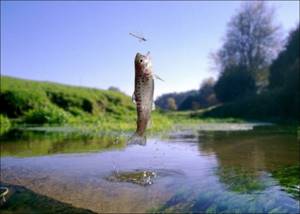
Trout is very unpretentious in its diet: everything is eaten, so this type of salmon gains weight very quickly. The fish forages for insect larvae and catches insects by jumping out of the water. She especially loves to eat bloodworms in the period after spawning. Therefore, in May and June, trout constantly jump out of the water in search of food to fatten up.
When the fry reach a sufficiently large size, they begin to switch to feeding on fish. Trout becomes a predator that hunts young fish and frogs. Some individuals engage in cannibalism. But the basis of nutrition is still fish, beetles, tadpoles, mollusks, crustaceans, insects and their larvae. The predator attacks meat waste and fish offal.
Photo and Description of Trout | Color and Painting
Each type of trout has almost the same body shape, namely an elongated shape, slightly flattened on the sides. The trout's back smoothly turns into its head, medium in size in relation to body size. The mouth is relatively small, the eyes are small.
Male trout have more teeth in their mouths than females. At the same time, females are slightly larger than males.
The entire body of the trout is covered with very small scales, and is a dense protective layer. There are 2 fins on the back, one in the center, the other closer to the tail of the fish. The one closer to the tail is the adipose fin, or as it is also called, the false fin.
There are 3 Rows of Fins on the Trout Belly:
Abdominal;
Breasts;
And anal;
Well, the 4th fin is actually the Tail of the fish.
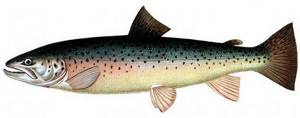
Speaking about its Color, it has different colors and has the ability to change. The most important thing on which color depends is: Habitat, and the actual appearance of the trout itself.
For example, if the bottom of the reservoir where the trout lives is quite light, then the color of the fish also has light shades: a silver body, with round black spots and a light back, olive color. Accordingly, on a muddy or any other dark bottom, the color of the trout will be darker.
Also, it is worth considering that Trout can change its Color during spawning periods. The colors of the trout become much brighter and more saturated.
Brook trout has a dark, or almost black back. She needs it for camouflage. It is simply full of black and red spots, which is why it got its name - Pestrushka.
3 ways to improve your fish bite!
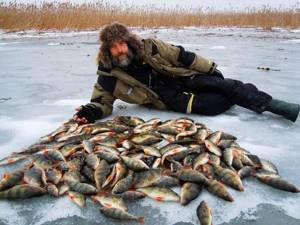
Over 15 years of active fishing, I have found many ways to improve the bite, and here are the most effective:
1. Bite activator . This pheromone additive attracts fish most strongly in cold and warm water. The Fish Hungry bite activator has proven itself to be excellent - Read more…
2. Tackle with increased sensitivity . You should first familiarize yourself with the features of using a particular type.
3. Pheromone baits . They attract the attention of fish, stimulate hunger and cause a schooling reflex, which allows you to collect a lot of fish in one place.
You can get the rest of the secrets of successful fishing for free by reading my other materials on the site.
3 ways to improve your fish bite!
Over 15 years of active fishing, I have found many ways to improve the bite, and here are the most effective:
1. Bite activator . This pheromone additive attracts fish most strongly in cold and warm water. The Fish Hungry bite activator has proven itself to be excellent - Read more…
2. Tackle with increased sensitivity . You should first familiarize yourself with the features of using a particular type.
3. Pheromone baits . They attract the attention of fish, stimulate hunger and cause a schooling reflex, which allows you to collect a lot of fish in one place.
You can get the rest of the secrets of successful fishing for free by reading my other materials on the site.
Rainbow trout is light in color. Unlike other species of trout, it has a reddish stripe along the entire lateral line of the fish's body. Only thanks to this stripe did it get its name - rainbow trout.
Reproduction
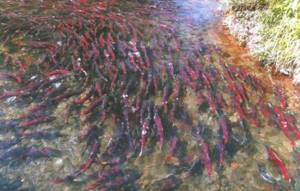
Trout spawning usually occurs in the spring or fall. The spawning period occurs once a year, and its timing depends on the habitat and local climate. As spawning grounds, fish choose shallow waters with fast currents and a bottom covered with stones and pebbles. The diameter of live eggs can reach 5 millimeters; they are colored yellow or red, as in the photo.
Scientists note one peculiarity in trout fish species. During the development of eggs, only trout exhibit so many deformities. Scientists consider albinism and hermaphroditism as deformities. There are cases where fish hatched with two heads.
Thus, trout occupies a special position among all fish species. Trout will never cease to be valuable due to the fact that as a result of its active fishing, fish populations are significantly reduced. If overfished, there will be a threat of its extinction.
Description of trout
Russia is home to freshwater trout, which belongs to the salmon family. The climatic conditions of our country allow it to live in lakes, streams or small rivers, and artificial reservoirs.
Trout is a predatory fish with a body from 25 to 35 cm long (for an adult), slightly flattened on the sides. The head of this fish is short, with two rows of sharp and thin teeth in the mouth. Trout is quite strong with a small weight (from 200 to 600 g), and this must be taken into account when choosing gear for catching it.
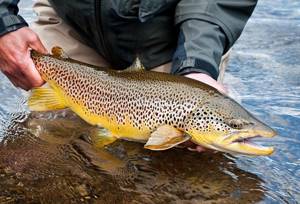
Larger trout live in Karelia - from 2 to 5 kg. This is due to the presence of large amounts of food in local lakes. The body of the Karelian lake trout is covered with small golden scales with a greenish tint, a number of dark spots on the sides and a short but pronounced fin on the ridge. It is interesting that the color of trout scales can change and depends on the characteristics of the habitat, time of year, food and other external factors.
Fishing
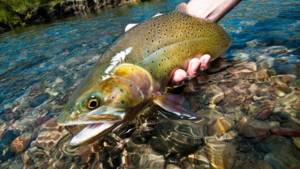
Trout fishing is exciting, but quite difficult; the most important thing is to choose the right place. To do this, you can take the advice of experienced fishermen or simply try the bite in different places. The fishing season begins with the opening of the river; you can also catch trout in winter. But in each specific area there are certain rules and restrictions on fishing.
In early spring, trout are caught in water with a slight current below the riffles; in these places there are a lot of small fish, larvae and frogs, so trout love them. Fishing is carried out using spinning, float and fly fishing tackle.
Prevalence
Living in close family proximity makes it difficult to determine their affiliation and causes confusion and controversy among scientists.
Read here Flounder - types of fish, tackle, bait and features of flounder fishing (110 photos)
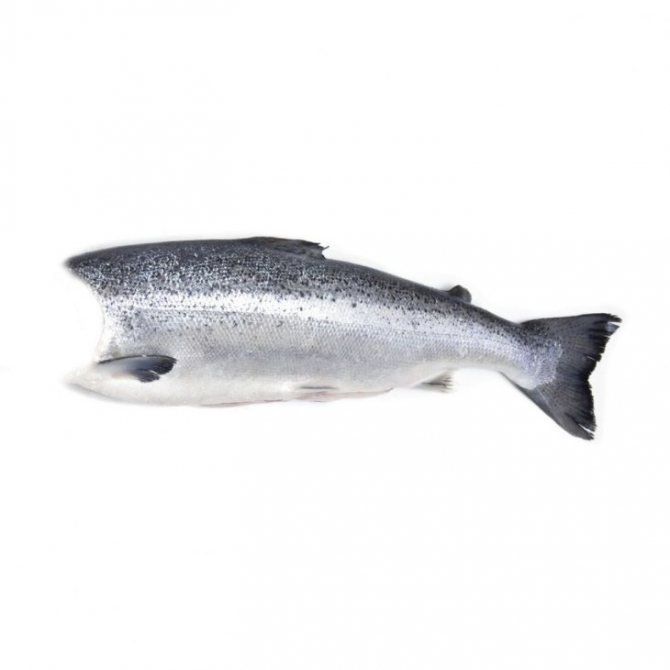
Trout swims in many places, but more often it ends up on the table in those houses that are located closer to its location. And there are quite a few such places.
Found in North America, along the Pacific Ocean and in the North Atlantic. Closer to the shores of the White, Barents, Baltic. And also Northern and Norwegian, to the coast of Pechora. It goes along the White Sea and Barents Sea coasts to the Czech Bay.
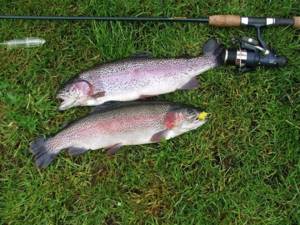
According to some data, marine classes can be found within the Black and Caspian Seas. Precisely wild ones, not artificially grown ones.
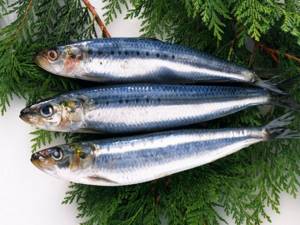
Features of trout fishing
Regardless of the conditions in which you have to catch trout, you must have certain skills. To catch this beautiful fish, you will have to demonstrate all your skill and skill.
In addition, it will not be amiss to familiarize yourself with the nature of the reservoir, learn about its features and the location of promising places. But the most important thing is the availability of suitable gear and catchable baits. If all the nuances are taken into account, then you can always count on catching this amazing fish.
Brook trout fishing
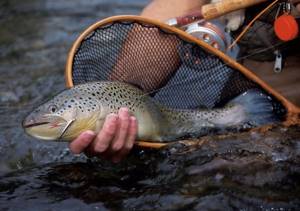
Brook trout fishing is more actively practiced by anglers, since fishing is carried out in natural conditions. When fishing, you should remember that this type of trout is quite shy and cautious. If you consider that the river where the trout lives is fairly clear water, then it can easily notice the silhouette of a fisherman. In order not to frighten the fish once again, it is better to move along the river in the direction of the current. What makes fishing interesting is that it is quite difficult to catch brook trout. In addition, you have to move along the river, the banks of which are overgrown with vegetation, and this is another serious obstacle.
Rainbow trout fishing
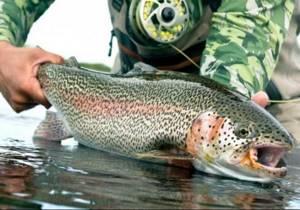
Rainbow trout are not particularly shy like brook trout, so they are not as difficult to catch. It is especially not difficult to catch it on a paid reservoir, where it is mainly caught. To catch it, it is better to select brightly colored baits. As a rule, trout bite well on red or yellow wobblers or flies. No less catchy are rotating spoons with bright petals, as well as widely used silicone baits that imitate the movements of various insects.
Lake trout fishing
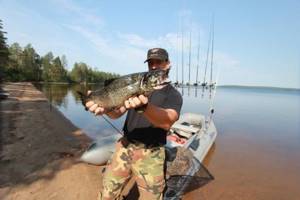
Lake trout are characterized by a constant habitat. This type of trout becomes attached to the place where there is a sufficient amount of food. She can live here throughout her life.
Anglers are aware of this fact and with great pleasure go to the lakes with the hope of catching lake trout, which, in terms of taste, is not much different from other types of trout.
Lake trout are being actively caught on flies. The main thing is to determine which fly is currently catching fish. As many anglers testify, the ideal option is to fish with a larvae or dry fly in clear or flowing water. If the water is still, then you should give preference to a wet fly.
Lake trout lives in many water bodies in Russia. At the same time, you should always remember that trout can only be active in clear, clean water. When fishing in still water, it is better to use a wet fly.
When fishing in summer, it is better to look for trout in the depths, where they escape the summer heat. It is very important to know the moments when the fish are feeding, then the catch is guaranteed.
How to catch river trout
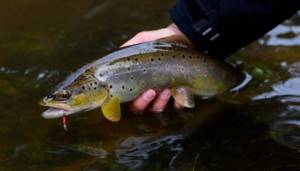
River trout prefer fast water. Such areas are characterized by cool and clear water, with a rapid current. In addition, such areas should have a rocky bottom or flooded trees.
Characteristics and description of the species
Almost all types of trout look the same. On average, they weigh from 200 to 500 grams, and their length is approximately 35 centimeters. But in the wild there are individuals whose weight can reach 2 kg. The largest trout weighed over 5 kilograms.
As you can see from the photo, all trout species have a similar body shape. The body is elongated and slightly flattened on the sides, so from the outside it looks a little flat. The muzzle of this fish is truncated, the eyes are small. Females are more impressive in size, but males have more teeth in their mouths. Over time, their upper jaw may curve upward.
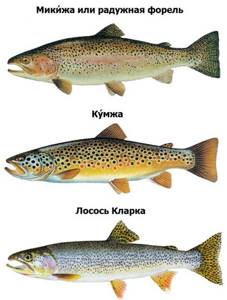
The tail and fins are of medium size. The pelvic fin has a yellow color, and numerous inclusions are visible on the dorsal fin. Trout fish are covered with small scales. The photo shows that there are main and false fins on the back. A similar feature is found not only in the trout family, but also in other salmon fish.
The color of the fish depends on what species the individual belongs to, where it lives, what it eats, and the degree of transparency of the water. Trout living on light bottoms have a silvery color. The back has a slight olive tint interspersed with black. The sides may have a yellow or greenish tint. Individuals whose habitat is a bottom surface containing silt or peat are distinguished by a darker color. The color of river varieties changes closer to the breeding season, becoming brighter. The body of brook trout is brown, the back and head are black. There are many black and reddish dots over the entire surface of her body. Therefore, this subspecies has another name - pestle.
Rainbow trout is distinguished from other subspecies by its light color. On the side there is a rainbow stripe that shimmers in different colors. Shades can vary from purple to deep orange. The fish owes its name to this stripe. In spawning males, its orange color becomes more saturated.
Family
The entire salmon family is formed by seven genera. Trout are found in the Pacific, Atlantic and char genera.
Pacific salmon include subspecies: rainbow, golden sea, Caucasian, Apache, Gila, and Biva salmon.
Atlantic salmon fish are also called by another name - noble salmon. The genus is formed by subspecies: Amudarya, Adriatic, Ohrid, marbled, flathead, Sevan and brown trout.
Char includes the following subspecies: silver, big-headed, lake, Malma and Palia.
Trout species
In the Russian Federation there are three species of fish of the trout family:
- Ruchevaya,
- Ozernaya,
- Rainbow.
To have a better understanding of this valuable fish, here is a brief description of each species.
Brook trout is a freshwater form of the family. It is characterized by sedentary behavior, so the fish does not leave its native reservoir. A comfortable environment for brook trout are fast-flowing rivers and streams with clean water. On average, the weight of one freshwater individual does not exceed 2 kg. But, according to some fishing enthusiasts, in the wild there are specimens that weigh 12 kilograms.
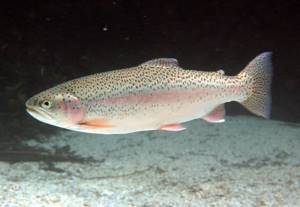
Lake trout live in cold, deep lakes. Its other names are brown trout and Karelian trout. It inhabits Ladoga, Onega and Karelian lakes, as well as lakes of the Kola Peninsula.
The fish is impressive in size, reaching a meter in length. Individuals gather in schools and stay at a depth of about 100 meters.
Rainbow trout is a subspecies of Pacific salmon that inhabits freshwater bodies. This type of trout predominates in the Russian Federation. Most of the fish farms are engaged in its breeding.
Also, this fish is used more often than others to fill paid reservoirs. Its fishing is carried out in different ways using natural or artificial baits. Since this breed is very athletic, rainbow trout fishing competitions are sometimes held.
What does it eat?
Trout fish is an aquatic predator. At the initial stage of life, the diet of its juveniles consists mainly of plankton. With the transition to adulthood, the fish begins to eat more variedly. Her diet is:
- Small fish;
- crustaceans;
- Worms and other invertebrates inhabiting the bottom;
- Larvae of insects living near bodies of water;
- Little frogs;
- Bugs, butterflies and insects that have fallen into the water.
Larger individuals can attack and eat not very large mammals that dare to swim across a body of water. Trout also eat plant foods. In reservoirs that practice paid fishing for this predatory fish, bait is used in the form of canned corn kernels, bread, and pieces of dough.

Predatory fish or not
Trout is a predator because, along with food of plant origin, it eats:
- Small fish;
- Small insects, their larvae;
- Plankton.
Its diet includes frogs, chicks and even its own young.
Spawning
The spawning process of trout fish differs depending on their species and habitat. Lake trout spawn twice during the year. The first period begins in December and ends in February, and the second period begins in June and ends in August. Fish spawn at fairly large depths, up to 100 meters. For this reason, the process has been little studied by specialists in the field of ichthyology. The female is capable of laying 1.5 thousand eggs. In the future, fry hatch from them, no larger than 15 millimeters in size. Brook trout reaches sexual maturity in the 3rd – 4th year of its life cycle. During the year, she spawns only once. This period occurs in November - December, when the temperature inside the reservoir is approximately + 6 degrees above zero. To lay eggs, the female looks for fast-flowing rocky and pebble areas in shallow water. At one time, she can lay from 200 to 500 eggs. With the onset of the first days of spring, fry begin to hatch from them.
Rainbow trout begin spawning at 3 or 4 years of their life cycle. Fish in the wild spawn from March to April. The maturation of large eggs, reaching a diameter of up to 6 mm, occurs within two months. The female lays an average of 2 thousand eggs.
Rainbow trout differs from brook trout in more intensive growth rates. Also, it is not afraid of heating the water column to +20˚С. It is this variety that is preferred to be bred in fish farms and paid reservoirs, because it does not require the creation of special conditions for cultivation.
Habitats
Brown trout do not feel comfortable in warm water, so their habitat is where there are springs flowing and the water remains cool. It can be found in shallow water in river beds behind all kinds of shelters. Trout love areas with slow current, stopping either in front of or behind them.
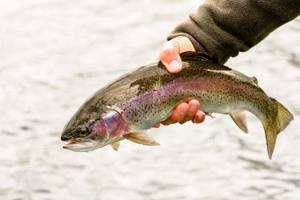
In the summer months, it lives in shallow holes with a slow current, located in the shade of the crowns of trees and bushes.
Rainbow trout leads a lifestyle similar to its brook variety. During stops, it hides behind snags, stones and in uneven terrain. In clear weather, the fish moves little, and with the advent of cloudy days, dramatic changes in its behavior occur; the trout begins a period of active hunting.
Lake trout live in lakes at depths of 50 to 100 meters. It is located near the bottom surface or moves in the water. In summer it often approaches the coastal zone.
What color is the meat
Different types of trout fish have different meat colors. In individuals raised in the wild, it is white, pink and red. This feature depends on where the fish lived, what and how much it ate.
The fish that arrives en masse on store shelves and on the market is white trout artificially bred by farmers. The color of its meat is either white or with a pink tint.
What gear do you need?
Trout can be caught:
- Using a float rod.
- Using spinning.
- Using fly fishing.
It is very important to choose a place where productive fishing is possible. If fishing is carried out on a paid reservoir, then the places are known. If fishing is carried out in an unknown body of water, then you will have to start identifying productive places.
An equally important factor influencing the effectiveness of fishing is the fishing season, which begins from the moment the ice disappears from the surface of water bodies.
With the arrival of spring, it is better to look for trout in areas that can support fish. From the moment the water level rises and the water loses its transparency, you can forget about effective trout fishing.
Lures used
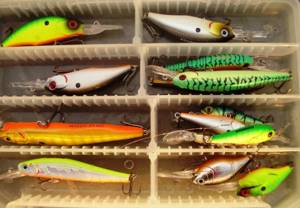
The main baits for trout fishing are:
- Wobblers of various colors.
- Flies, also bright colors.
- The fly is mainly used as bait.
Nowadays, the easiest way to catch trout is on a paid reservoir. As for natural conditions, everything is not so simple here, since many factors are included that affect the effectiveness of fishing.
The main choice always remains with the fisherman: to fish in nature or in a paid reservoir.

